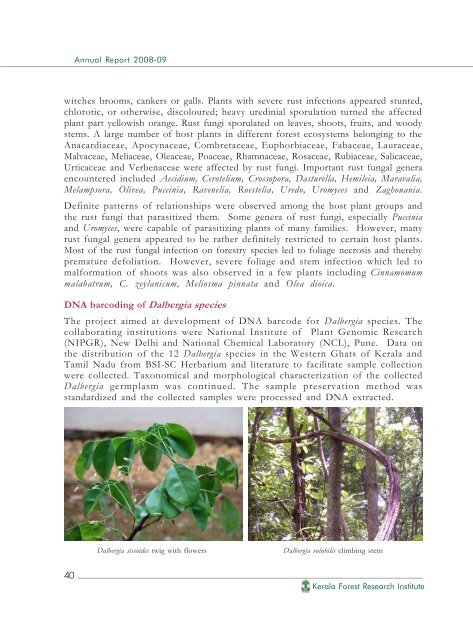2008-'09 - Kerala Forest Research Institute
2008-'09 - Kerala Forest Research Institute
2008-'09 - Kerala Forest Research Institute
You also want an ePaper? Increase the reach of your titles
YUMPU automatically turns print PDFs into web optimized ePapers that Google loves.
Annual Report <strong>2008</strong>-09<br />
witches brooms, cankers or galls. Plants with severe rust infections appeared stunted,<br />
chlorotic, or otherwise, discoloured; heavy uredinial sporulation turned the affected<br />
plant part yellowish orange. Rust fungi sporulated on leaves, shoots, fruits, and woody<br />
stems. A large number of host plants in different forest ecosystems belonging to the<br />
Anacardiaceae, Apocynaceae, Combretaceae, Euphorbiaceae, Fabaceae, Lauraceae,<br />
Malvaceae, Meliaceae, Oleaceae, Poaceae, Rhamnaceae, Rosaceae, Rubiaceae, Salicaceae,<br />
Urticaceae and Verbenaceae were affected by rust fungi. Important rust fungal genera<br />
encountered included Aecidium, Cerotelium, Crossopora, Dasturella, Hemileia, Maravalia,<br />
Melampsora, Olivea, Puccinia, Ravenelia, Roestelia, Uredo, Uromyces and Zaghouania.<br />
Definite patterns of relationships were observed among the host plant groups and<br />
the rust fungi that parasitized them. Some genera of rust fungi, especially Puccinia<br />
and Uromyces, were capable of parasitizing plants of many families. However, many<br />
rust fungal genera appeared to be rather definitely restricted to certain host plants.<br />
Most of the rust fungal infection on forestry species led to foliage necrosis and thereby<br />
premature defoliation. However, severe foliage and stem infection which led to<br />
malformation of shoots was also observed in a few plants including Cinnamomum<br />
malabatrum, C. zeylanicum, Meliosma pinnata and Olea dioica.<br />
DNA barcoding of Dalbergia species<br />
The project aimed at development of DNA barcode for Dalbergia species. The<br />
collaborating institutions were National <strong>Institute</strong> of Plant Genomic <strong>Research</strong><br />
(NIPGR), New Delhi and National Chemical Laboratory (NCL), Pune. Data on<br />
the distribution of the 12 Dalbergia species in the Western Ghats of <strong>Kerala</strong> and<br />
Tamil Nadu from BSI-SC Herbarium and literature to facilitate sample collection<br />
were collected. Taxonomical and morphological characterization of the collected<br />
Dalbergia germplasm was continued. The sample preservation method was<br />
standardized and the collected samples were processed and DNA extracted.<br />
Dalbergia sissoides twig with flowers<br />
Dalbergia volubilis climbing stem<br />
40<br />
<strong>Kerala</strong> <strong>Forest</strong> <strong>Research</strong> <strong>Institute</strong>

















